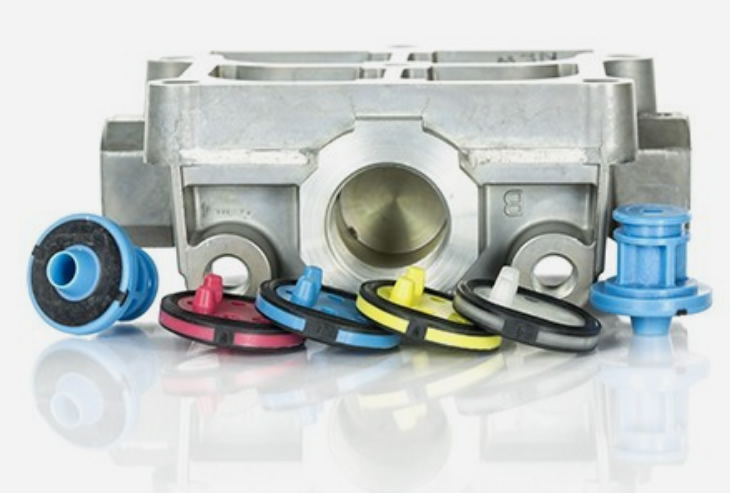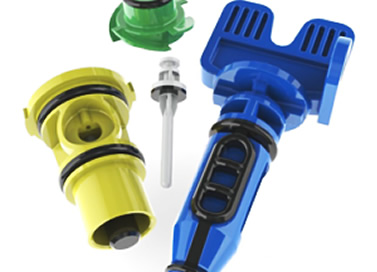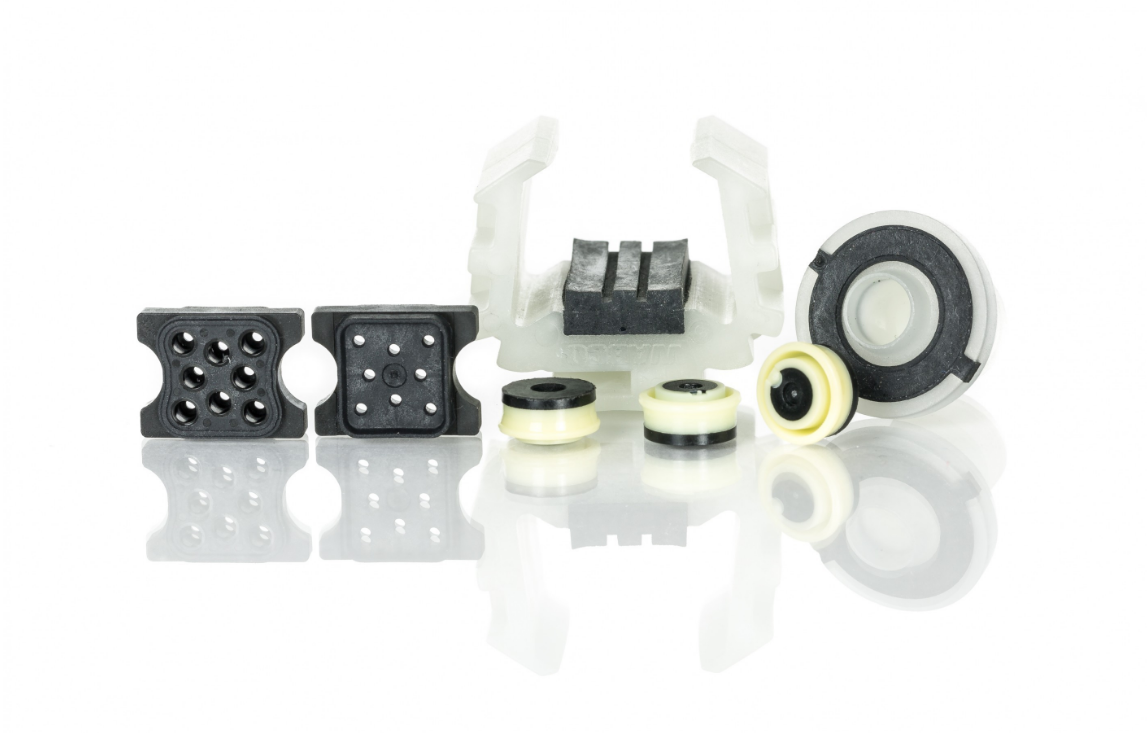2-Shot molding / 2K molding / Bi-injection molding


Description
2 Shot molding(2 component molding / 2K molding / 2K injectiong) optimises the co-polymerisation of hard and soft materials to create a powerful molecular bond.
Ming-Li uses thermoplastic elastomers and plastics for the 2 Shot moulding(2 component molding / 2K molding / 2K injection) process as traditional thermoset compounds (such as nitriles, fluorocarbons, EPDM’s) are not suitable.

Range
- Styrene Block Copolymers (TPE-S)
- Thermoplastic Polyurethane Block Copolymers (TPE-U)
- Copolyesters (TPE-E)
- Copolyamides (TPE-A)
- Olefinic Thermoplastic rubbers (TPE-O)
Ming-Li typically uses the following plastic materials for 2 Shot moulding(2K molding / 2K injection) :
- Polyamide (PA/Nylon)
- Polybutylene Terephtalate (PBT)
- Polycarbonates (PC)
- Polypropylene (PP)
The 2 Shot moulding process allows us to design and manufacture complex, multiple material parts for our customers to perform a sealing function.
Additionally, the multi-shot moulding process can also be used as a cost effective method to bond materials in different colours for cosmetic purposes.

Two shot molding / 2K molding Design Guide
Remember that 2 Shot molding is rarely used to cover the entire base substrate. Instead, apply 2 Shot molding in sections. For each of these, keep in mind these useful design tips:
- Work with your manufacturing partner to ensure the compatibility between the substrate and the TPE or TPU.
- Use a TPE or TPU that has a melt temperature lower than that of the base plastic.
- Apply an overmold that is slightly thinner than the substrate which supports it.
- Design the overmold to sit just below the surface of the substrate.
- If you need more holding power, design undercuts, keyways, and other mechanical features to lock the materials together.
Key elements for two shot molding / 2K molding
Two-shot molding, also known as two-shot injection molding or dual-shot molding, is a specialized manufacturing process that enables the production of complex parts with different materials or colors in a single molding cycle. Key elements of two-shot molding include:
Mold Design: The design of the mold is critical for two-shot molding. It must incorporate multiple cavities or cores to accommodate the two different materials or colors being injected sequentially. Mold design considerations include gating, parting lines, cooling channels, and alignment features.
Material Selection: Two-shot molding requires selecting compatible materials that can bond together during the molding process. Typically, a rigid thermoplastic is used for the first shot (substrate), and a softer thermoplastic or elastomer is used for the second shot (overmold). Material compatibility, adhesion properties, and performance requirements must be carefully evaluated.
Injection Molding Machine: Two-shot molding requires a specialized injection molding machine capable of performing sequential injections of different materials or colors. The machine must have multiple injection units, barrels, and nozzles to facilitate the two-shot molding process.
Injection Molding Process Parameters: Optimizing injection molding process parameters is essential for achieving uniform filling of the mold cavities and proper bonding between the two materials. Parameters such as temperature, pressure, injection speed, and hold time must be carefully controlled for each shot to ensure part quality and consistency.
Material Handling and Mixing: In two-shot molding, the first shot material is injected into the mold cavity, followed by a second shot of a different material or color. Proper material handling and mixing systems are necessary to ensure accurate dosing and mixing of the materials, as well as precise injection timing and sequencing.
Tooling and Tool Maintenance: Maintaining precision tooling is crucial for achieving high-quality two-shot molded parts. The mold must be designed for easy maintenance and cleaning to minimize downtime and ensure consistent part production. Regular maintenance and inspection of the mold are essential for extending tool life and preventing defects.
Part Ejection and Handling: After the two-shot molding process is complete, the molded parts must be ejected from the mold cavities and handled carefully to avoid damage or distortion. Proper part ejection mechanisms and handling systems are necessary to ensure efficient production and maintain part quality.
Quality Control and Inspection: Implementing robust quality control measures and inspection procedures is essential for verifying part dimensions, surface finish, and material properties. Inspection methods may include visual inspection, dimensional measurement, and testing for material adhesion and strength.
By addressing these key elements effectively, manufacturers can optimize the two-shot molding process to produce high-quality parts with complex geometries, integrated features, and multi-material compositions for a wide range of applications across industries.
Ming-Li Capabilities in 2-Shot Molding / 2K Molding
Ming-Li Precision offers advanced capabilities in 2-shot molding, also known as 2K molding, which involves the injection of two different materials or colors into a single mold to create a multi-material or multi-colored part. This process is highly valued in industries requiring complex designs, enhanced functionality, and aesthetically appealing products.
Key Capabilities in 2-Shot Molding / 2K Molding
-
Advanced Multi-Material Molding:
- Precision in Material Combination: Ming-Li specializes in the precise combination of different materials, such as rigid and soft plastics, within the same part. This capability is essential for applications where parts require both structural strength and flexibility.
- Complex Part Design: The 2-shot molding process enables the production of complex components that combine different materials or colors without the need for additional assembly. Ming-Li excels in producing parts with intricate designs and tight tolerances.
-
State-of-the-Art Equipment:
- High-Precision Injection Machines: Ming-Li utilizes cutting-edge injection molding machines specifically designed for 2-shot molding. These machines are capable of precise control over the injection process, ensuring consistent quality in every part.
- Efficient Production: The use of advanced machinery allows for efficient production cycles, reducing lead times and costs. This makes 2-shot molding an attractive option for high-volume production runs.
-
Design and Engineering Expertise:
- Custom Mold Design: Ming-Li’s engineering team works closely with clients to design custom molds that optimize the 2-shot molding process. This includes considerations for material compatibility, flow dynamics, and part performance.
- Mold Flow Analysis: By using advanced mold flow analysis software like Autodesk Moldflow, Ming-Li ensures that the molding process is optimized for uniform material distribution, reducing the risk of defects such as warping or incomplete fills.
-
Surface Finish and Aesthetic Quality:
- High-Quality Surface Finish: Parts produced using 2-shot molding often have superior surface finishes compared to parts produced with secondary operations. Ming-Li’s expertise ensures that the final product meets high aesthetic and functional standards.
- Multi-Color and Multi-Material Parts: The 2-shot molding process allows for the integration of multiple colors and materials in a single part, which is particularly beneficial for consumer products, electronics, and automotive components where appearance is critical.
-
Applications of 2-Shot Molding / 2K Molding:
- Consumer Products: High-quality, durable parts with enhanced tactile features, such as soft-touch grips or ergonomic designs.
- Automotive Components: Parts that combine different materials for functional or aesthetic purposes, such as buttons, handles, and dashboard components.
- Medical Devices: Multi-material components that require precise control over material properties for safety and functionality.
- Electronics: Encapsulated parts with integrated gaskets or seals, improving product performance and durability.
-
Quality Assurance:
- Stringent Quality Control: Ming-Li implements rigorous quality control measures throughout the 2-shot molding process, ensuring that each part meets exacting standards for performance, durability, and appearance.
- IATF 16949 Certification: Ming-Li’s commitment to quality is reflected in its IATF 16949 certification, which aligns its production processes with the high standards required by the automotive industry.
Ming-Li Precision's expertise in 2-shot molding, supported by advanced machinery and deep engineering knowledge, positions the company as a leader in producing complex, multi-material, and multi-colored parts. With a strong focus on quality, efficiency, and innovation, Ming-Li is an ideal partner for industries requiring precision-engineered components with enhanced functionality and aesthetic appeal. Whether for high-volume production or intricate, custom designs, Ming-Li delivers 2-shot molded parts that meet the most demanding specifications.

What is the different between Two-Shot Injection Molding and Overmolding?
1. Definition:
- Two-Shot Injection Molding:
- A process where two different materials are injected into the mold during two separate, but continuous, cycles. The first material is injected into the mold to form the substrate, and the second material is injected onto or around the substrate in the same machine, creating a single integrated part.
- Overmolding:
- A process where a second material is molded over an already existing part (substrate) in a separate molding cycle. The substrate is typically produced in a different machine or process and then placed into the overmolding tool for the second shot.
2. Process Complexity:
- Two-Shot Injection Molding:
- Requires a specialized machine with two barrels to handle the two different materials. The process is more complex due to the need for precise timing and coordination between the two injections, but it is highly efficient for large-scale production.
- Overmolding:
- Involves a simpler setup as it can be done with standard injection molding machines, albeit with multiple stages. The complexity arises in ensuring proper adhesion between the overmolded material and the substrate, often requiring surface treatments or primers.
3. Material Compatibility:
- Two-Shot Injection Molding:
- Materials used must be compatible, not just in terms of adhesion but also in their processing temperatures and shrinkage rates. Typically, the first shot is a rigid material, and the second shot is a softer, more flexible material.
- Overmolding:
- Offers more flexibility in material selection as the materials are molded in separate steps. Adhesion is critical, but it can be enhanced through additional steps like surface treatments, adhesives, or primers. It allows the use of different materials that may not be processed together in a single shot.
4. Design Flexibility:
- Two-Shot Injection Molding:
- Highly flexible in design, allowing for complex geometries and integrated features like seals, hinges, or multi-material parts. The integrated nature of the process can result in parts that are more durable and have a better bond between materials.
- Overmolding:
- Allows for flexibility in design but with some limitations. The need to handle the substrate between processes can limit the complexity of designs. However, it is well-suited for applications requiring different materials with distinct functions.
5. Production Efficiency:
- Two-Shot Injection Molding:
- More efficient for high-volume production because it eliminates the need for separate handling and secondary operations. The parts are completed in one cycle, reducing production time and labor costs.
- Overmolding:
- Generally less efficient compared to two-shot molding due to the need for multiple steps and possible additional handling. However, it is ideal for smaller production runs or when existing parts need to be overmolded.
6. Cost Considerations:
- Two-Shot Injection Molding:
- Higher initial costs due to the specialized machinery and tooling required. However, it becomes cost-effective in the long run for high-volume production because of the efficiency and reduced labor costs.
- Overmolding:
- Lower initial investment as it can be done with standard machines and molds. However, it may have higher per-part costs due to the extra handling and potential need for surface preparation.
7. Application Examples:
- Two-Shot Injection Molding:
- Commonly used for parts requiring multiple materials with distinct properties, such as toothbrushes (hard handle and soft grip), automotive switches, and medical devices with integrated seals.
- Overmolding:
- Frequently used for encapsulating electronic components, creating soft-touch grips on tools, or adding rubber seals to rigid plastic components.
8. Final Product Quality:
- Two-Shot Injection Molding:
- Typically results in a more homogeneous part with superior bonding and seamless transitions between materials. The parts often exhibit higher durability and improved aesthetics.
- Overmolding:
- Can achieve high-quality parts but may face challenges with bonding strength and uniformity between the materials. Quality largely depends on the preparation and compatibility of the materials used.
Summary:
- Two-Shot Injection Molding is ideal for high-volume production of complex, multi-material parts with excellent material bonding and integration.
- Overmolding is more suited for applications where flexibility in material selection is needed, or when modifying existing parts, although it may involve additional steps and handling.
Comparison of Two-Shot Injection Molding and Overmolding
| Criteria | Two-Shot Injection Molding | Overmolding |
|---|---|---|
| Definition | Two different materials are injected into the mold in two separate, continuous cycles, creating a single integrated part. | A second material is molded over an already existing part (substrate) in a separate molding cycle. |
| Process Complexity | Requires specialized equipment with two barrels and precise timing and coordination. | Can be done with standard injection machines but involves multiple stages and ensuring material adhesion. |
| Material Compatibility | Materials must be compatible in terms of adhesion, processing temperatures, and shrinkage rates. Typically, the first shot is a rigid material, and the second is flexible. | Offers more flexibility in material selection; adhesion can be enhanced through surface treatments or primers. |
| Design Flexibility | High design flexibility, allowing for complex geometries and integrated features like seals and hinges. | Less flexibility, especially when handling substrates, but suitable for applications requiring different material functions. |
| Production Efficiency | More efficient for high-volume production as it eliminates the need for separate handling and secondary operations. | Generally less efficient due to multiple steps and extra handling, ideal for smaller production runs or modifying existing parts. |
| Cost Considerations | Higher initial costs due to specialized machinery and tooling but cost-effective for high-volume production. | Lower initial investment but may have higher per-part costs due to extra handling and surface preparation. |
| Application Examples | Toothbrushes (hard handle and soft grip), automotive switches, and medical devices with integrated seals. | Encapsulating electronic components, soft-touch grips on tools, adding rubber seals to rigid plastic components. |
| Final Product Quality | Typically results in a more homogeneous part with superior bonding and seamless transitions between materials. | Can achieve high-quality parts but may face challenges with bonding strength and uniformity between materials. |
Both processes have their unique advantages and are selected based on specific project requirements, including design complexity, material compatibility, production volume, and cost considerations.
Ming-Li Precision 2-Shot molding / 2K molding Project
Know more for 2 Shot Molding
This type of plastic 2 shot molding, sometimes called two-shot, multi-shot, or double-injection molding, adds additional material such as thermoplastic elastomer (TPE) to plastic substrates to improve the aesthetics, handling characteristics, grip, impact resistance, or environmental resistance of injection molded parts. The 2 shot molding process is usually performed by way of multi-barrel injection molding machines, the process adding additional material shortly after the substrate is formed to create strong bonds between materials. Plastic 2 shot molding serves to eliminate steps in the manufacturing process while creating enhanced injection molded products.
Depending on the materials selected for the substrate and overmold, materials may be bonded chemically or mechanically (via undercuts, for example). In many instances, mechanical bonding is recommended to fortify any chemical bonding that may take place. Among the many substrate materials that are suited to 2 shot molding, polycarbonate, ABS, HDPE, and nylon are common. Overmold materials include thermoplastic elastomers like thermoplastic polyurethane (TPU), thermoplastic rubber (TPR), and thermoplastic vulcanite (TPV), as well as materials like styrene-ethylene/butylene-styrene copolymer (SEBS). Silicone overmolding is also used, especially when a softer rubber surface is needed for a plastic part.
This is just a partial overview of 2 Shot molding(2 component molding / 2K molding / 2K injection). Are they the right solutions for you? Not sure how to apply them to your next project? Just contact our technical experts and we can offer helpful advice about how to get the best results from both processes.
https://ceetak.com/seal-products/2-shot-moulding/





